A) Only I
B) Only II
C) Only III
D) I and II
F) B) and C)
Correct Answer

verified
B
Correct Answer
verified
Multiple Choice
Which of the following statements about an E1 mechanism is not true?
A) It is a two-step process and has the same first step as an SN1 mechanism.
B) It involves the formation of a carbocation from eliminating a good leaving group.
C) A common competing reaction is rearrangement of a less stable carbocation to a more stable carbocation.
D) The loss of a proton by the carbocation is a slow step.
F) A) and C)
Correct Answer

verified
Correct Answer
verified
Multiple Choice
Which of the following statements about an E1 mechanism is true?
A) The identity of the leaving group affects the rate of reaction.
B) The reaction follows second-order kinetics.
C) The reaction is slowest with tertiary substrates.
D) Polar aprotic solvents favor the E1 mechanism.
F) C) and D)
Correct Answer

verified
Correct Answer
verified
Multiple Choice
What is the product of the following reaction?
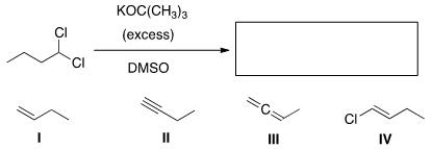
A) I
B) II
C) III
D) IV
F) All of the above
Correct Answer

verified
Correct Answer
verified
Multiple Choice
Which of the following statements about the mechanism of an E2 reaction is true?
A) All bonds are broken and formed in multiple steps.
B) The reaction is not concerted.
C) Entropy favors the reactants of an E2 reaction.
D) Entropy favors the products of an E2 reaction.
F) A) and B)
Correct Answer

verified
Correct Answer
verified
Multiple Choice
What is (are) the product(s) of the following reaction?
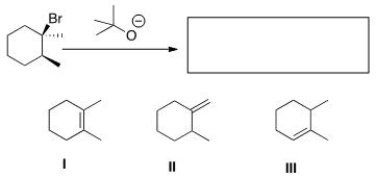
A) I and II
B) II and III
C) I and III
D) I, II, and III
F) All of the above
Correct Answer

verified
D
Correct Answer
verified
Multiple Choice
Which of the following alkenes is the most stable?

A) I
B) II
C) III
D) IV
F) B) and D)
Correct Answer

verified
A
Correct Answer
verified
Multiple Choice
What is (are) the product(s) of the following reaction?
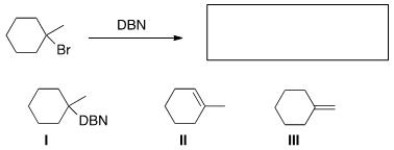
A) Only I
B) Only II
C) Only III
D) II and III
F) A) and B)
Correct Answer

verified
Correct Answer
verified
Multiple Choice
What is the major elimination product obtained from the following reaction?
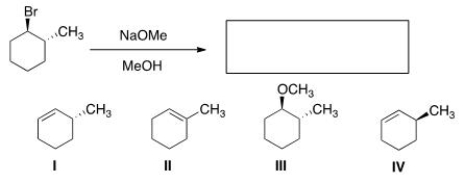
A) I
B) II
C) III
D) IV
F) A) and C)
Correct Answer

verified
Correct Answer
verified
Multiple Choice
Which of the following is the dihalide that can be used to prepare the alkyne below?

A) I and II
B) II and III
C) I and III
D) I, II, and III
F) None of the above
Correct Answer

verified
Correct Answer
verified
Multiple Choice
Classify each alkene in vitamin D3 labeled I, II, III by the number of carbon substituents bonded to the double bond. 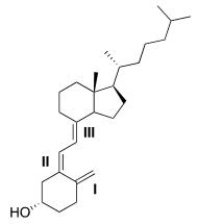
A) I = Disubstituted; II = trisubstituted; III = trisubstituted.
B) I = Monosubstituted; II = disubstituted; III = trisubstituted.
C) I = Disubstituted; II = disubstituted; III = trisubstituted.
D) I = Disubstituted; II = trisubstituted; III = disubstituted.
F) A) and B)
Correct Answer

verified
Correct Answer
verified
Multiple Choice
Which of the following alkyl chloride affords alkene A exclusively under E2 reaction condition?

A) I
B) II
C) III
D) IV
F) B) and C)
Correct Answer

verified
Correct Answer
verified
Multiple Choice
Which of the following statements about an E1 mechanism is not true?
A) The reaction is fastest with tertiary alkyl halides.
B) A better leaving group makes the reaction rate increase.
C) The reaction follows first-order kinetics.
D) Stronger bases favor the E1 reaction.
F) B) and C)
Correct Answer

verified
Correct Answer
verified
Multiple Choice
How many different E2 products can form from the dehydrohalogenation of 2-bromobutane?
A) 1
B) 2
C) 3
D) 4
F) B) and C)
Correct Answer

verified
Correct Answer
verified
Multiple Choice
Which of the following is the dihalide that can be used to prepare the alkyne below?

A) Only I
B) Only II
C) Only III
D) II and III
F) A) and B)
Correct Answer

verified
Correct Answer
verified
Multiple Choice
Which of the labeled protons in the compound below is most readily abstracted under E2 conditions?
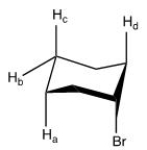
A) Ha
B) Hb
C) Hc
D) Hd
F) B) and C)
Correct Answer

verified
Correct Answer
verified
Multiple Choice
Which of the following is the least reactive substrate in an E2 reaction?

A) I
B) II
C) III
D) IV
F) All of the above
Correct Answer

verified
Correct Answer
verified
Multiple Choice
Which of the following alkyl halide reacts the fastest in an E2 reaction?

A) I
B) II
C) III
D) IV
F) C) and D)
Correct Answer

verified
Correct Answer
verified
Multiple Choice
What is the most likely mechanism for the reaction below?

A) SN1
B) SN2
C) E1
D) E2
F) B) and D)
Correct Answer

verified
Correct Answer
verified
Multiple Choice
What is the major elimination product obtained from the following reaction?

A) I
B) II
C) III
D) IV
F) A) and C)
Correct Answer

verified
Correct Answer
verified
Showing 1 - 20 of 43
Related Exams